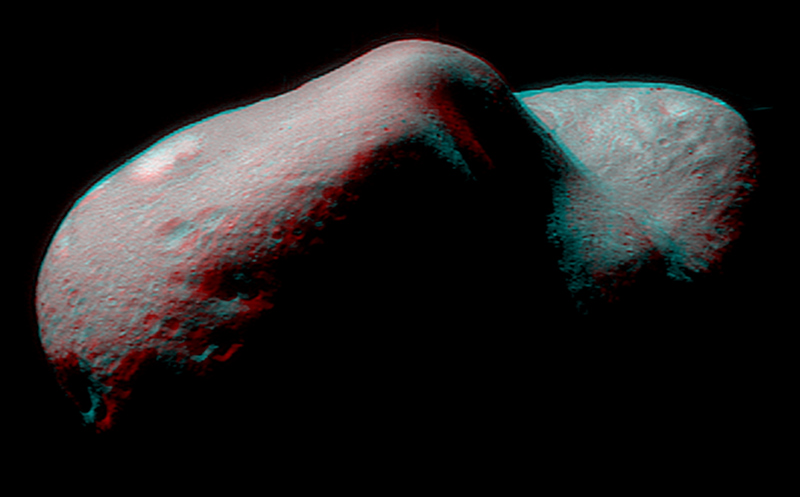2021年02月13日
Stereo Eros
Image Credit: NEAR Project, JHU APL, NASA
Explanation: Get out your red/blue glasses and float next to asteroid 433 Eros. Orbiting the Sun once every 1.8 years, the near-Earth asteroid is named for the Greek god of love. Still, its shape more closely resembles a lumpy potato than a heart. Eros is a diminutive 40 x 14 x 14 kilometer world of undulating horizons, craters, boulders and valleys. Its unsettling scale and unromantic shape are emphasized in this mosaic of images from the NEAR Shoemaker spacecraft processed to yield a stereo anaglyphic view. Along with dramatic chiaroscuro, NEAR Shoemaker’s 3-D imaging provided important measurements of the asteroid’s landforms and structures, and clues to the origin of this city-sized chunk of Solar System. The smallest features visible here are about 30 meters across. Beginning on February 14, 2000, historic NEAR Shoemaker spent a year in orbit around Eros, the first spacecraft to orbit an asteroid. Twenty years ago, on February 12 2001, it landed on Eros, the first ever landing on an asteroid’s surface. NEAR Shoemaker’s final transmission from the surface of Eros was on February 28, 2001.
Tomorrow’s picture: a name for NGC 2237
爱神星的立体影像
影像提供: NEAR Project, JHU APL, NASA
说明: 请取出你的红/蓝眼镜,体验漂浮在爱神星(433 Eros)旁边的感受。每1.8年绕行太阳一圈的这颗近地小行星,是以希腊神话的爱神为名。虽然如此,它的形状其实较像马铃薯而非爱心。长40公里、宽14公里、高14公里的这颗小天体,是个由起伏地平线、撞击坑、巨石和低谷聚成的世界。它的尺寸及很不浪漫的形状,在这幅由NEAR舒梅克卫星拍摄的照片合成之立体拼接影像里清楚可见。在这幅表面图里,NEAR舒梅克卫星的影像,为它的地形、结构及这颗都市大小的太阳系小天体,提供重要的量测数据。影像里,可解析的最小结构约为30公尺。从2000年2月14日起,NEAR舒梅克卫星以一年的时间绕行爱神星,成为首艘绕行小行星的地球太空船。而在2001年2月12日,它着陆在爱神星表面,成为首艘着陆在小行星的探测船。在2001年2月28日,NEAR舒梅克卫星最一次从爱神星表面回传讯息。
明日的图片: a name for NGC 2237




中文正文的第二行译错了
433Eros为爱神星,并非阋神星
已更正,谢谢
中文正文第二行译错了
433EROS是爱神星,而非阋神星。